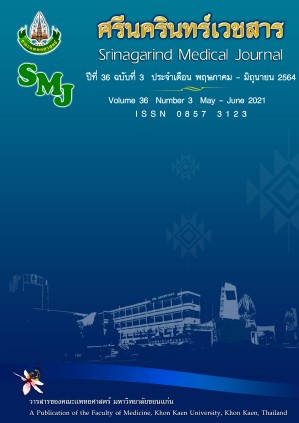ความแข็งแรงของกล้ามเนื้อหายใจและการทำงานของกล้ามเนื้อ anterior scalene ในผู้หญิงที่มีอาการปวดคอเรื้อรัง
Abstract
หลักการและวัตถุประสงค์: อาการปวดคอเรื้อรังส่งผลกระทบต่อระบบกล้ามเนื้อและกระดูกบริเวณคอ และอาการล้าของกล้ามเนื้อบริเวณรอบหัวไหล่และทรวงอก การศึกษาครั้งนี้วัตถุประสงค์เพื่อเปรียบเทียบความแข็งแรงของกล้ามเนื้อหายใจ และการทำงานของกล้ามเนื้อ anterior scalene (AS) ในผู้ที่มีอาการปวดคอเรื้อรัง กับอาสาสมัครไม่มีอาการปวดคอ
วิธีการศึกษา: อาสาสมัคร 10 คนที่มีอาการปวดคอเรื้อรังมากกว่า 6 เดือน และ อาสาสมัครไม่มีอาการปวดคอ 10 คน ทำการทดสอบความแข็งแรงของกล้ามเนื้อหายใจ และวัดการทำงานของกล้ามเนื้อ anterior scalene ขณะทำการทดสอบความแข็งแรงของกล้ามเนื้อหายใจ
ผลการศึกษา: อาสาสมัครที่มีอาการปวดคอพบว่า ความแข็งแรงของกล้ามเนื้อหายใจเข้าและออก มีค่าต่ำกว่าอาสาสมัครที่ไม่มีอาการปวดคอ(51.1 ± 5.5 และ 72.5 ± 4.9 cmH2O, p < 0.001) และ (59.1 ± 3.3 และ 80.0 ± 3.4 cmH2O, p < 0.001) ขณะทำการทดสอบความแข็งแรงของกล้ามเนื้อหายใจเข้าในอาสาสมัครที่มีอาการปวดคอมีค่าการทำงานของกล้ามเนื้อ AS ทั้งข้างขวาและซ้าย สูงกว่าอาสาสมัครที่ไม่มีอาการปวดคอ (58.7 ± 11.8 และ 46.1 ± 6.7, p < 0.05) และ (62.9 ± 14.2 และ 47.6 ± 3.8, p < 0.05) ตามลำดับ
สรุป: อาสาสมัครที่มีอาการปวดคอเรื้อรังมากกว่า 6 เดือน มีความแข็งแรงของกล้ามเนื้อหายใจน้อยกว่ากลุ่มที่ไม่มีอาการปวดคอ และ กล้ามเนื้อ AS ทำงานเพิ่มมากขึ้น ขณะทำการทดสอบความแข็งแรงของกล้ามเนื้อหายใจเข้าเมื่อเปรียบเทียบกับกลุ่มที่ไม่มีอาการปวดคอ
คำสำคัญ: ปวดคอเรื้อรัง; ความแข็งแรงของกล้ามเนื้อหายใจ; การทำงานของกล้ามเนื้อ
Background and objectives: Chronic neck pain affects the musculoskeletal system in the neck, and fatigue of the muscles around the shoulder and thoracic wall. This study aimed to compare respiratory muscle strength, and anterior scalene (AS) muscle activity in participants with chronic neck pain and participants without neck pain.
Method: Ten participants with chronic neck pain over six months and ten participants without neck pain performed respiratory muscle strength tests and measured AS muscle activity while performing the respiratory muscle strength test.
Results: Participants with neck pain found that respiratory muscles strength inhalation and exhalation were lower than participants without neck pain (51.1 ± 5.5 and 72.5 ± 4.9 cmH2O, p <0.001) and (59.1 ± 3.3 and 80.0 ± 3.4 cmH2O, p <. 0.001). During the inhalation muscle strength test, AS muscle activity of right and left site in participants with neck pain were higher than subjects without neck pain (58.7 ± 11.8 and 46.1 ± 6.7, p <0.05) and (62.9 ± 14.2 and 47.6 ± 3.8, p <0.05) respectively.
Conclusion: Participants with chronic neck pain for more than 6 months had lower respiratory muscle strength than participants without neck pain and increases AS muscle activity while performing the inhaled muscle strength test compare with participants without neck pain.
Keywords: Chronic neck pain; Respiratory muscle strength; Muscle activity


